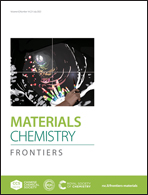A ferroelastic molecular rotator [(Me2N(CH2)2NH3)(18-crown-6)]triflate with dual dielectric switches†
Abstract
Molecular rotators possess a unique structure that facilitates the dynamic motion of building blocks to construct artificial molecular machines, which endows them with potential applications in the fields of information processing, sensing and energy conversion. Thus, they have attracted extensive scientific attention in recent years. However, molecular rotators coupling simultaneously special functional features such as ferroelasticity and dielectric switching have been rarely reported. Here, we report a new ferroelastic molecular rotator [(Me2N(CH2)2NH3)(18-crown-6)]Tf ([(N,N-dimethylethylenediammonium)(18-crown-6)]triflate) through regulating the building blocks (the stator and counterion) to realize “momentum matching” in the crystal structure. The compound shows a reversible paraelastic-ferroelastic phase transition with an Aizu notation of mmmF2/m at 295 K, and an isostructural phase transition at 304 K, which are accompanied concurrently by dielectric switching behaviors. The two sequential phase transitions of the compound result from the dynamic rotation of cations and anions. In this work, the deliberate design of the ferroelastic molecular rotator is obtained by simultaneously taking the molecule building blocks and intermolecular interactions. This might provide a new impetus in the field of molecular ferroelastics.
![Graphical abstract: A ferroelastic molecular rotator [(Me2N(CH2)2NH3)(18-crown-6)]triflate with dual dielectric switches](/en/Image/Get?imageInfo.ImageType=GA&imageInfo.ImageIdentifier.ManuscriptID=D2QM00319H&imageInfo.ImageIdentifier.Year=2022)


 Please wait while we load your content...
Please wait while we load your content...